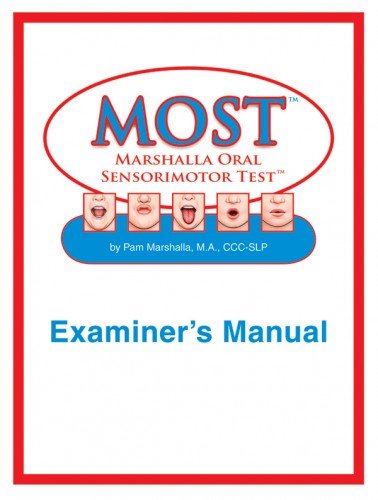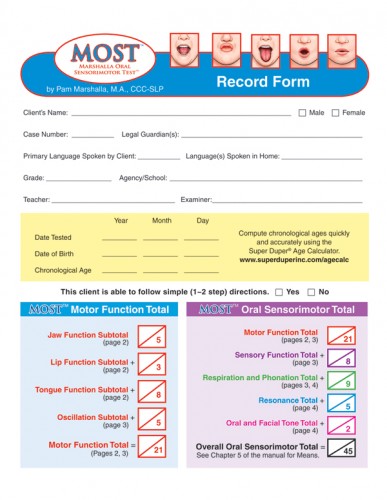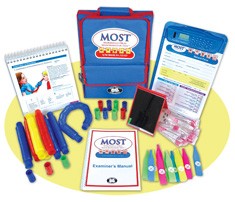Price $280.00
Contents
The Marshalla Oral Sensorimotor Test (MOST) is a comprehensive and quick assessment designed to put a numerical value on oral movement, oral-tactile sensitivity, facial and oral tone, as well as basic respiration, phonation, and resonation skills.
The MOST is the first exam to allow speech-language pathologists an opportunity to place a numerical value on the oral exam. It identifies jaw, lip, and tongue movement problems. It is optimal for children with concomitant feeding difficulties, neurological deficits, developmental disorders, and sensory processing disorders. The MOST normative sample is made up of 160 children from across the U.S.
The MOST provides an Overall Oral Sensorimotor Score as well as individual scores on subtests. You may use the scores to measure pre- and post treatment abilities. This easy-to-use evaluation allows the therapist to identify strengths and weaknesses in the following areas:
- Jaw Movements
- Lip Movements
- Tongue Movements
- Oscillating Jaw, Lip, and Tongue Movements
- Oral and Facial Tone
- Respiration and Phonation Skills
- Resonance
- Oral-Tactile Sensitivity
The subtests of the MOST allow the examiner to look closely at individual areas of speech motor control.
- The Motor Function subtests of the MOST are designed to identify a client's control of jaw, lip, and tongue movements and praxis through 21 simple probes.
- The Sensory Function subtest measures the client's responses to incoming tactile stimulation to various areas inside and outside of the oral cavity using multiple textures in 8 simple probes.
- The Respiration and Phonation subtest provides a child-friendly examination of basic respiration and phonation skills using kazoos and whistles.
- The Resonation subtest allows the examiner to put a numerical value of the characteristics of hyper- and hyponasality.
- The Oral and Facial Tone subtest provides two simple procedures for specifying muscular tone in the face, lips and tongue.
Speech-language pathologists often write general observations about respiration, phonation, resonation, and oral movement. The MOST allows speech-language pathologists to provide scores to back up their claims.
Large illustrations on the test easel are a beautiful guide provided for the therapist to use as a model for each test item.
-

Marshalla Oral Sensorimotor Test (MOST)
MOST Case History Forms (30)
$39.00 -

Marshalla Oral Sensorimotor Test (MOST)
MOST Examiner's Manual
$45.00 -

Marshalla Oral Sensorimotor Test (MOST)
MOST Oral-Motor Supplies Kit
$69.60 -

Marshalla Oral Sensorimotor Test (MOST)
MOST Record Forms (30)
$39.00 -

Marshalla Oral Sensorimotor Test (MOST)
MOST Test Kit Only
$224.00
No additional information available for this item.

 Proud to be Canadian
Proud to be Canadian
 *Contains small parts that may be a choking hazard for children under the age of 3.
*Contains small parts that may be a choking hazard for children under the age of 3. 